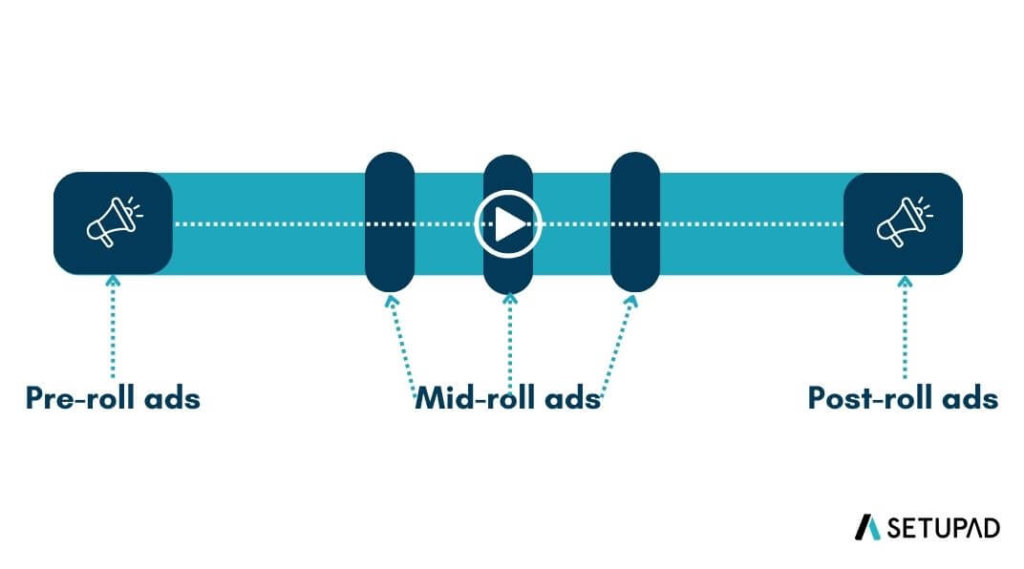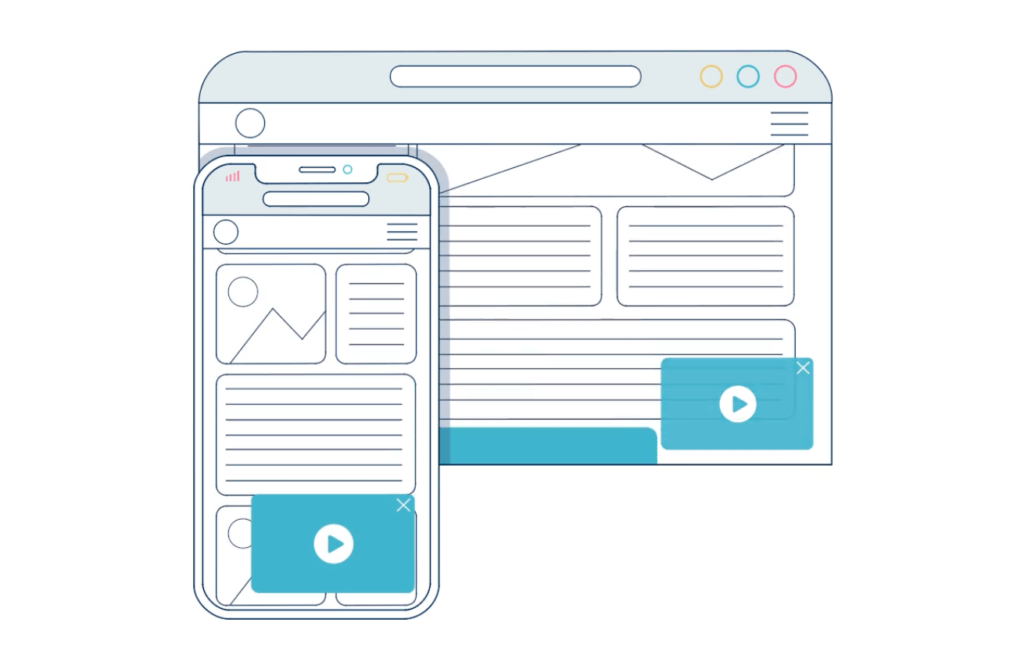What is OTT (Over-the-Top) in Programmatic Advertising?
Programmatic OTT advertising refers to the immediate and automated purchasing and distributing of ad slots on popular streaming services (e.g., Hulu, HBO Max). This applies to the platforms themselves and specific devices like connected TVs (CTVs).
OTT advertising is becoming increasingly important since most users move from cable TV to streaming content online. There are already hundreds of OTT media services available and that amount continues to grow rapidly.
This article explains what OTT advertising is, its benefits, ad types, and its importance in the current advertising landscape.
What is Over-the-Top (OTT)?
Over-the-top (OTT) stands for the ability to sidestep traditional media distribution channels, granting advertisers and media companies greater flexibility and access to detailed analytics to gauge ad effectiveness.
Nonetheless, the original term for a cable box is “set-top box”, which came from the early days of television when TVs were bulky and small cable boxes were placed on top.
However, as technology evolved and TVs became flat, the placement of these boxes changed, but the name “set-top box” persisted.
In contrast, streamed content doesn’t need a cable box because it’s delivered directly through the internet. This delivery method bypasses traditional set-top boxes, leading to the term “over-the-top” or OTT, indicating that the content goes “over” the conventional broadcasting method.
What is OTT Advertising?
OTT advertising delivers film and TV content online, bypassing traditional cable or satellite TV services. This “over-the-top” method allows viewers to access content on various devices, including mobiles, tablets, gaming consoles, desktops, and smart TVs.
Essentially, OTT ads are TV ads presented to viewers through connected TV (CTV) devices or streaming services. As viewers increasingly shift towards streaming platforms over traditional TV, OTT advertising offers a unique opportunity for advertisers to reach new audiences at scale.
What is the difference between OTT and CTV?
OTT is the term that covers the delivery of content through devices that are connected to the internet. CTV on the other hand refers to the device that delivers video content (e.g., Amazon Fire Stick, Roku.)
OTT and CTV both are modern methods of content delivery that offer viewers the freedom to watch their desired content on their schedule, unlike the fixed timetables of conventional TV.
This on-demand feature is a hallmark of both.
Their rise has led to substantial shifts in the media landscape. For advertisers and brands (the demand side), and for content creators and distributors (the supply side), these platforms have introduced new opportunities and challenges.
Essentially, OTT and CTV have revolutionized the way audiences engage with video content, posing a significant challenge to traditional TV broadcasting. The subsequent data presumably highlights their growing influence and reach.
What are the central figures in OTT advertising?
The table below provides a comprehensive overview of the 12 main players in the OTT advertising ecosystem and their respective roles.
| Figure | Role |
| OTT platforms | Providers of exclusive streaming content. Examples include Netflix, Hulu, Disney+, and Discovery+. They host the content viewers watch and often have ad spaces available for advertisers. |
| Connected Devices/OTT Devices | Physical devices that enable streaming on screens, such as Chromecast, Roku, and Amazon Fire TV Stick. They facilitate the delivery of OTT content to viewers. |
| Smart TVs | TVs with built-in streaming capabilities. Examples are Samsung TV, LG TV, and TCL TV. They provide a platform for OTT content and ads directly without needing an additional device. |
| Mobile Measurement Partners (MMPs) | Third-party entities that assist advertisers in measuring campaign performance accurately and combating ad fraud. They ensure that ad metrics are reliable and trustworthy. |
| Supply-side platforms (SSPs) | Software solutions managing the advertising exchange from the publisher’s side. They handle the sale of ad space, optimize deals, and measure campaign performance. |
| Demand-side platforms (DSPs) | Programmatic tools that facilitate ad buys and provide inventory in a unified interface. They streamline the process of purchasing ad spaces for advertisers. |
| Advertisers | Entities that pay to promote their products or services. They create ads and seek platforms or spaces to display them to potential customers. |
| Publishers and Networks | Those who sell advertising inventory, including broadcasters, OTT platforms, and CTV devices. They offer spaces where ads can be displayed to viewers. |
| Agencies | Middlemen that manage, optimize, buy, negotiate, consult, and sell ads on behalf of advertisers. They bridge the gap between advertisers and publishers. |
| Ad Servers | Platforms or tools that manage and execute the serving of ads (e.g., DoubleClick). They ensure that ads are delivered to the right spaces at the right times. |
| Viewers | The audience or consumers who watch the videos where ads are displayed. They are the target of the advertisements. |
| Aggregators | Services holding large inventories across multiple platforms. They sell ad inventory in bulk, offering a wide reach for advertisers. |
Types of OTT ads
Here are 7 main types of OTT ads:
Banner ads. Static visual ads that appear either at the top or bottom of the screen when viewing content. They do not interrupt the content being watched.
Overlay ads. These are pop-up ads that appear either at the bottom or top of the screen as you’re viewing content. They are typically clickable and lead you to a designated landing page.
In-video ads. These ads pause your content and play a video ad that lasts anywhere from 5 to 30 seconds. They can appear:
- Pre-roll: Before your video starts.
- Mid-roll: During your video, preferably at natural breaks.
- Post-roll: After your video has ended.

Picture-in-picture ads. When a smaller video ad plays in a corner of the screen while the main content continues.
Interactive ads. These ads offer a level of interaction, such as clicking a link, taking a survey, or engaging in another manner.
Companion banner ads. These are banner ads that appear alongside the main video. They usually promote a brand’s website or social media channels.
Outstream video ads. These video ads are not placed within the main content. Instead, they appear in different settings like in an article, a feed, or as a banner.

OTT ad delivery process
Many streaming services offer ad-supported tiers, integrating ads with their video content.
The delivery of OTT ads can be through client-side ad insertion (CSAI), where the video player requests an ad during streaming, or server-side ad insertion (SSAI), where ads are seamlessly integrated into the video stream, offering a smoother viewer experience.
The ad campaign process involves:
- Defining a target audience.
- Creating a compelling ad.
- Selecting the ad format.
- Choosing the right inventory or platform to display the ad.
Once the content is hosted on an OTT platform, ads can be inserted either through client-side ad insertion (CSAI) or server-side ad insertion (SSAI).
CSAI involves the video player requesting an ad from the server during playback, while the SSAI seamlessly integrates ads into the content stream, offering a buffer-free viewing experience.
By leveraging OTT, publishers can ensure their content reaches a broader, more engaged audience while maximizing monetization opportunities.
OTT in Programmatic Advertising
OTT in programmatic advertising represents a significant evolution, merging the strengths of digital advertising with the expansive reach of television.
Programmatic advertising is the automated buying and selling of online ad space using technology. Instead of traditional manual negotiations and purchases, programmatic advertising uses algorithms and machines to purchase digital ads in real-time, allowing for more efficient and precise ad placements.
For publishers, integrating OTT with programmatic advertising means tapping into automated, real-time auction ad buying, streamlining the ad delivery process.
This integration allows publishers to maximize their ad inventory’s value by reaching specific audience segments with high precision. With viewers increasingly consuming content through streaming platforms, publishers can offer advertisers access to a captive and engaged audience.
How programmatic ads are delivered on OTT platforms?
On OTT platforms, programmatic ads are delivered through a process called real-time bidding (RTB). When a viewer accesses content on an OTT platform, an ad request is sent to an ad exchange.
This exchange then auctions off the ad space to the highest bidder in real-time, and the winning ad is delivered to the viewer instantly.
This entire process happens within milliseconds. The advantage of this system is that it allows advertisers to bid on ad space in real-time based on the specific profile of the viewer, ensuring that ads are highly targeted and relevant.
Benefits of Programmatic OTT
OTT platforms offer many benefits for publishers, primarily stemming from the evolving consumption habits of viewers increasingly favoring internet-based content over traditional broadcasting methods.
For publishers, OTT platforms present an opportunity to tap into a growing audience that prefers streaming content on-demand. This shift allows publishers to diversify their revenue streams by offering both subscription-based models and ad-supported content.
With OTT advertising, publishers can deliver targeted and personalized ads based on viewer preferences and behaviors, enhancing ad effectiveness and increasing revenue potential. Furthermore, OTT platforms provide detailed analytics and insights, enabling publishers to refine their content strategies and optimize ad placements.
The granular data available from OTT platforms, combined with programmatic capabilities, enhances the viewer’s experience by serving less obtrusive and more relevant ads and boosts the publisher’s ad revenue due to the premium placed on targeted ad slots.
- Targeting. Programmatic OTT allows advertisers to target specific audiences based on demographics, interests, viewing habits, etc. This ensures that ads are shown to the most relevant audience, increasing the likelihood of engagement.
- Real-time bidding. Advertisers can bid for ad slots in real-time, ensuring they get the best value for their ad spend, and can adjust their strategies on-the-fly based on performance metrics.
- Greater reach. OTT platforms have seen a surge in viewership, especially with the decline of traditional cable. Programmatic advertising on these platforms ensures brands can reach cord-cutters and cord-nevers, expanding their audience base.
- Unified buying experience: Programmatic OTT platforms often allow advertisers to manage their campaigns across multiple OTT services, streamlining the buying process and ensuring consistent messaging across platforms.
- Brand safety. Many programmatic platforms offer tools and controls to ensure that ads are placed in brand-safe environments, reducing the risk of ads appearing next to controversial or inappropriate content.
- Interactive ad formats. OTT platforms often support interactive ad formats, allowing viewers to engage with ads in ways not possible on traditional TV, leading to increased engagement and brand recall.
- Dynamic ad insertion. Publishers can seamlessly integrate ads into their content, ensuring a non-disruptive viewing experience for the audience.
- Real-time analytics. Publishers gain access to real-time data and insights, helping them understand viewer behavior and optimize their content strategy accordingly.
- Cross-device reach. Programmatic OTT allows publishers to reach audiences across a range of devices, from smart TVs to mobile devices, expanding their potential viewer base.
- Future-proofing. As the OTT landscape continues to grow and evolve, adopting a programmatic approach ensures publishers remain agile and can quickly adapt to industry changes and innovations.
OTT Monetization Models
Subscription-Based Video On Demand (SVOD)
SVOD model charges users a recurring fee for unlimited access to a vast content library.
Netflix and HBO Max are prime examples.
It’s the most dominant model, with a significant number of global subscribers. The model’s strength lies in its ability to offer personalized, uninterrupted content, with some variations like freemium models or theme-based content bundles.
However, the challenge is retaining subscribers due to the absence of long-term contracts.
Advertising-Based Video On Demand (AVOD)
AVOD offers free content supported by ads.
Platforms like YouTube and Roku operate on this model.
It’s ideal for services with vast audiences, and its popularity is on the rise, with projections indicating substantial growth in the coming years.
Transactional Video On Demand (TVOD)
TVOD is the digital equivalent of renting or buying a movie.
Users pay for individual videos, either for permanent access (Electronic Sell-Through) or temporary access (Download to Rent).
Amazon Prime Video and Google Play Movies are examples. It’s often used as an additional offering alongside SVOD or AVOD.
Premium Video On Demand (PVOD)
PVOD is a variation of TVOD.
PVOD allows users to pay a premium to access content earlier than the general public. This model gained more attention during the COVID-19 pandemic when traditional movie theaters were closed.
Hybrid Video On Demand (HVOD)
HVOD refers to streaming services that combine multiple monetization strategies, typically blending ad-supported content with subscription tiers.
Unlike standalone models like SVOD or AVOD, HVOD integrates elements from various models, allowing platforms to generate revenue through commercials and subscription fees.
Popular platforms like Netflix, Disney+, and Hulu utilize the HVOD approach, offering different viewing experiences at various prices.
Free Ad-Supported Tv (FAST)
Free ad-supported TV (FAST) refers to streaming platforms that offer scheduled programming to users at no cost, generating revenue through commercial breaks and other advertising techniques.
Unlike traditional subscription-based models or on-demand platforms, FAST channels provide a linear viewing experience, similar to traditional broadcast television, but delivered over the internet.
This model has been gaining traction as it allows viewers to access content without a subscription fee, while advertisers benefit from a digital platform to reach their target audience. Examples of FAST platforms include the Roku Channel and Pluto TV.
Targeting Strategies in OTT Programmatic Advertising
In OTT programmatic advertising, targeting strategies have evolved to be more precise and aligned with digital media practices.
Traditional program-based buying is giving way to more nuanced targeting methods. Advertisers can integrate first-party data from their Data Management Platforms (DMP) or Mobile Measurement Partners (MMP) to create lookalike audiences and enhance retargeting, optimizing the relevance of their campaigns.
- Platform targeting ensures ads are shown on specific OTT operating systems.
- Behavioral targeting uses lookalike data, psychographic, demographic, and TV-centric data from providers like Samba TV and Inscape to target users based on their viewing habits.
This data can be further enriched using Automatic Content Recognition (ACR) technology, which links mobile user data to CTV by recognizing content viewed on CTV through smartphone microphones.
- Content targeting allows advertisers to place ads within specific OTT app groupings or even specific apps, ensuring they reach users based on the content they consume. Additionally, interest-based profiles can be expanded by combining web and app data from various DMPs.
- Retargeting strategies can be employed to first raise awareness on OTT and then retarget those users on mobile or web platforms to drive acquisition.
Challenges and Limitations of OTT Programmatic Advertising
The OTT advertising landscape is still in its early stages, leading to a limited inventory of ad spaces compared to more established platforms like mobile apps and websites. This scarcity intensifies competition among advertisers for prime ad slots, causing the cost per thousand impressions (CPMs) to rise.
As a result, programmatic advertisers, who rely on automated bidding systems, often find their bids unused due to the high costs.
Furthermore, with top-tier ad spaces often fully booked, advertisers might be compelled to venture into lesser-known, potentially less effective inventory sources.
One of the main challenges is the intense competition from industry giants like Google, Apple, Facebook, and Amazon, which often leaves smaller players struggling for visibility.
The rise of “walled gardens” further complicates the landscape, leading to market consolidation.
Ad fraud and viewability concerns
OTT platforms generally experience lower ad fraud rates than other digital advertising mediums but aren’t immune. The absence of standardized ad quality regulations makes them susceptible to sophisticated ad fraud schemes, causing significant financial losses.
Attribution and measurement challenges
The CTV and OTT sectors face challenges in measurement and addressability. Unlike other mature programmatic channels, they currently lack comprehensive tools to measure ad performance and target specific audiences accurately.
Another pressing concern is the myriad of device-specific IDs, hardware, and software, which delay the establishment of a unified industry standard for accurate measurement and reporting.
Lastly, with an abundance of OTT services and the average household subscribing to multiple services, achieving accurate cross-channel attribution becomes a daunting task, despite its critical importance to marketers.
Trends and Future of OTT in Programmatic Advertising
The OTT industry will significantly grow and evolve in the coming years. As the adoption of smartphones and smart TVs rises, there will be an increased demand for OTT content, leading to more platforms offering a broader range of content.
A key strategy for platforms like Netflix and Amazon Prime has been their investment in original content, setting them apart from competitors. This emphasis on unique shows and movies is expected to intensify.
To enhance user engagement, OTT platforms will likely introduce interactive features like live chats, polls, and quizzes. Additionally, to offer a richer user experience, the integration of Augmented Reality (AR) and Virtual Reality (VR) is anticipated.
Recognizing the diverse tastes of global audiences, OTT services will also focus on expanding regional and niche content. Lastly, integrating Artificial Intelligence (AI) and Machine Learning (ML) will revolutionize content recommendations, tailoring them based on individual user behavior and preferences.
Conclusion
Programmatic OTT stands out as a game-changer, bridging the gap between traditional and digital TV. As audiences increasingly migrate to streaming platforms like Hulu, HBO Max, and Disney+, advertisers can tap into this shift, leveraging real-time, automated ad placements tailored to specific viewer preferences.
While challenges such as standardization and ad fraud persist, integrating advanced technologies like AI and machine learning promises enhanced targeting and measurement capabilities.
As OTT platforms continue to grow and diversify their content offerings, the importance of programmatic advertising in this space will only become more evident.
Advertisers and publishers alike must stay abreast of these trends, ensuring they harness the full potential of OTT to deliver impactful, relevant, and engaging ad experiences to audiences worldwide.
FAQs (Frequently Asked Questions)
What is OTT in programmatic advertising?
OTT in programmatic advertising refers to the automated ad buying on streaming platforms that deliver content over the internet, bypassing traditional TV methods.
How does OTT programmatic advertising work?
OTT programmatic advertising uses technology to buy and sell ad space in real-time on streaming platforms, targeting specific audiences based on set criteria.
Can programmatic ads be blocked on OTT platforms?
Unlike web browsers, OTT platforms generally don’t support ad-blocking, ensuring ads have higher visibility.
What are the benefits of OTT programmatic advertising?
Benefits include precise targeting, real-time campaign optimization, access to a broader audience, cost efficiency, and enhanced measurement capabilities.
How can advertisers measure the effectiveness of OTT programmatic ads?
Advertisers can use metrics like view-through rates, conversion rates, audience reach, frequency, and other engagement indicators to measure effectiveness.


